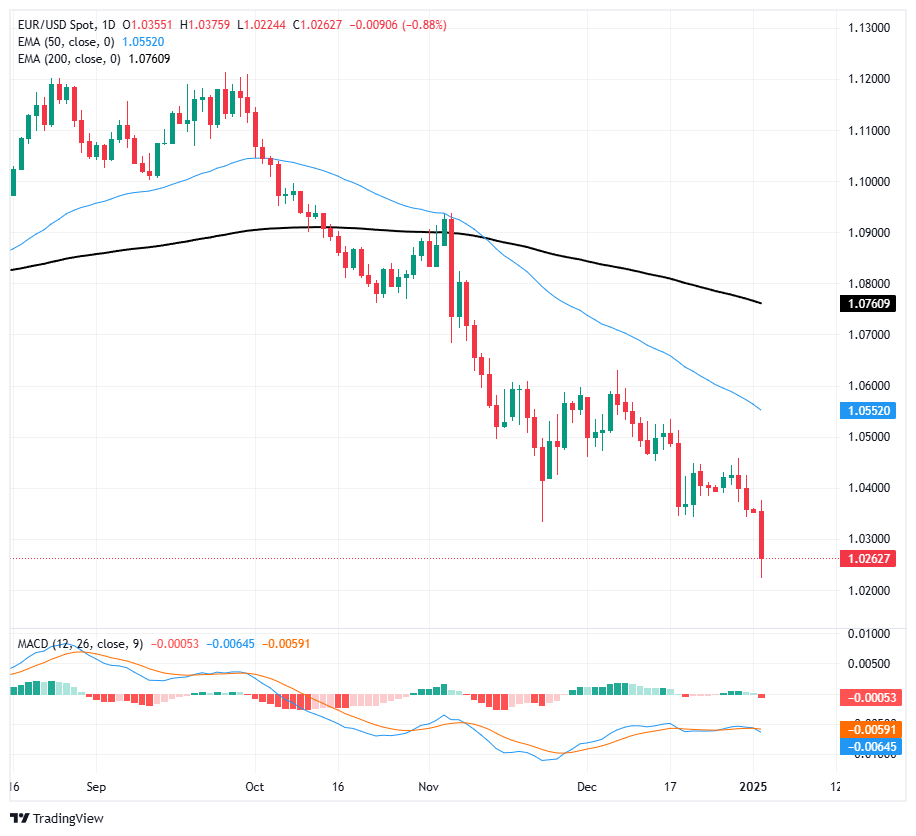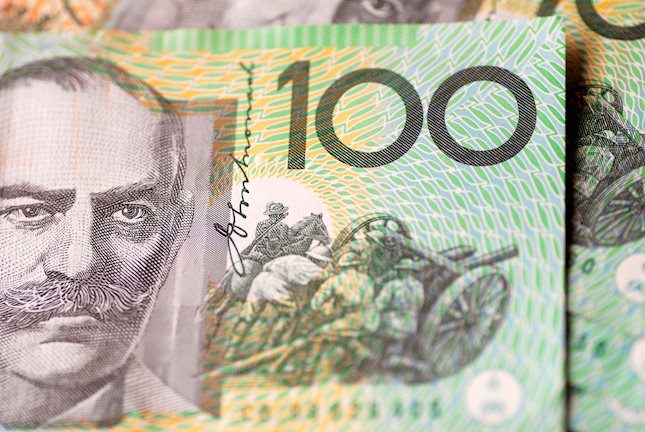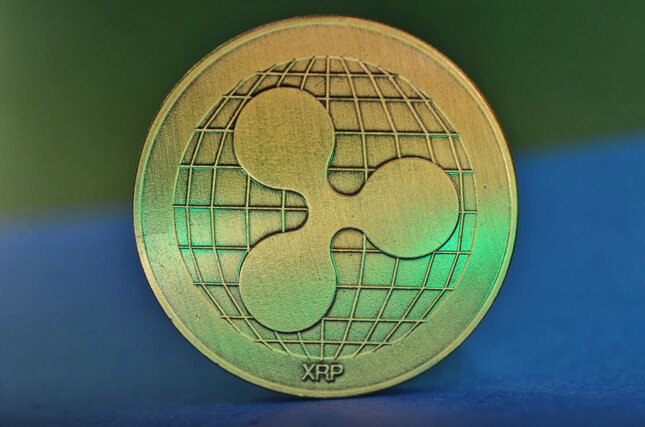- EUR/USD shed another full percent as Euro fears simmer.
- European Manufacturing PMI missed the mark, implying steepening contraction expectations.
- ECB policies are expected to diverge steeply from the Fed this year.
EUR/USD dumped another full percentage point on Thursday, kicking off 2025 with its lowest prices in two years. The Euro fell below 1.0250 against the Greenback since November of 2022 and putting Fiber on pace to close for a fourth straight month in the red if things don’t improve in January.
Pan-European Manufacturing Purchasing Managers Index (PMI) survey results fell slightly in December, ticking down to 45.1 versus the expected hold at 45.2. While the data itself had a relatively low impact, it helped to highlight the increasing likelihood that the European Central Bank (ECB) would accelerate rate cuts to bolster the European economy, even as petrol prices hit their own two-year highs.
Coupled with a Federal Reserve (Fed) that is set to cut rates slower than expected, the interest rate divergence underpinning EUR/USD is set to widen dramatically in the coming months. Some analysts expect the Euro to return to parity against the US Dollar sometime in the next 12 months.
EUR/USD price forecast
EUR/USD is down 8.82% top-to-bottom from September’s peak bids just above the 1.1200 handle, though short-sellers remain unable to pierce 1.0200 for now. A bearish divergence on the Moving Average Convergence-Divergence (MACD) indicator is getting hard to ignore, implying further technical losses on the horizon.
Fiber bids are getting pushed further down by a descending 50-day Exponential Moving Average (EMA) falling into 1.0550. If bidders are able to stage a comeback beyond this point, the 200-day EMA will be waiting just above at 1.0760.
EUR/USD daily chart
Euro FAQs
The Euro is the currency for the 19 European Union countries that belong to the Eurozone. It is the second most heavily traded currency in the world behind the US Dollar. In 2022, it accounted for 31% of all foreign exchange transactions, with an average daily turnover of over $2.2 trillion a day. EUR/USD is the most heavily traded currency pair in the world, accounting for an estimated 30% off all transactions, followed by EUR/JPY (4%), EUR/GBP (3%) and EUR/AUD (2%).
The European Central Bank (ECB) in Frankfurt, Germany, is the reserve bank for the Eurozone. The ECB sets interest rates and manages monetary policy. The ECB’s primary mandate is to maintain price stability, which means either controlling inflation or stimulating growth. Its primary tool is the raising or lowering of interest rates. Relatively high interest rates – or the expectation of higher rates – will usually benefit the Euro and vice versa. The ECB Governing Council makes monetary policy decisions at meetings held eight times a year. Decisions are made by heads of the Eurozone national banks and six permanent members, including the President of the ECB, Christine Lagarde.
Eurozone inflation data, measured by the Harmonized Index of Consumer Prices (HICP), is an important econometric for the Euro. If inflation rises more than expected, especially if above the ECB’s 2% target, it obliges the ECB to raise interest rates to bring it back under control. Relatively high interest rates compared to its counterparts will usually benefit the Euro, as it makes the region more attractive as a place for global investors to park their money.
Data releases gauge the health of the economy and can impact on the Euro. Indicators such as GDP, Manufacturing and Services PMIs, employment, and consumer sentiment surveys can all influence the direction of the single currency. A strong economy is good for the Euro. Not only does it attract more foreign investment but it may encourage the ECB to put up interest rates, which will directly strengthen the Euro. Otherwise, if economic data is weak, the Euro is likely to fall. Economic data for the four largest economies in the euro area (Germany, France, Italy and Spain) are especially significant, as they account for 75% of the Eurozone’s economy.
Another significant data release for the Euro is the Trade Balance. This indicator measures the difference between what a country earns from its exports and what it spends on imports over a given period. If a country produces highly sought after exports then its currency will gain in value purely from the extra demand created from foreign buyers seeking to purchase these goods. Therefore, a positive net Trade Balance strengthens a currency and vice versa for a negative balance.
Information on these pages contains forward-looking statements that involve risks and uncertainties. Markets and instruments profiled on this page are for informational purposes only and should not in any way come across as a recommendation to buy or sell in these assets. You should do your own thorough research before making any investment decisions. FXStreet does not in any way guarantee that this information is free from mistakes, errors, or material misstatements. It also does not guarantee that this information is of a timely nature. Investing in Open Markets involves a great deal of risk, including the loss of all or a portion of your investment, as well as emotional distress. All risks, losses and costs associated with investing, including total loss of principal, are your responsibility. The views and opinions expressed in this article are those of the authors and do not necessarily reflect the official policy or position of FXStreet nor its advertisers. The author will not be held responsible for information that is found at the end of links posted on this page.
If not otherwise explicitly mentioned in the body of the article, at the time of writing, the author has no position in any stock mentioned in this article and no business relationship with any company mentioned. The author has not received compensation for writing this article, other than from FXStreet.
FXStreet and the author do not provide personalized recommendations. The author makes no representations as to the accuracy, completeness, or suitability of this information. FXStreet and the author will not be liable for any errors, omissions or any losses, injuries or damages arising from this information and its display or use. Errors and omissions excepted.
The author and FXStreet are not registered investment advisors and nothing in this article is intended to be investment advice.
Recommended content
Editors’ Picks

AUD/USD side-lines near 0.6200 as traders await US NFP report
AUD/USD consolidates near 0.6200 early Friday, just above its lowest level since October 2022 as traders move to the sidelines ahead of Friday's closely-watched US NFP data releae. Meanwhile, rising bets for an early RBA rate cut, China's economic woes and US-Sino trade war fears act as a headwind for the Aussie.

USD/JPY bulls take a breather above 158.00 ahead of US NFP
USD/JPY takes a breather above 158.00 following the release of household spending data from Japan, slightly off the multi-month top amid wavering BoJ rate hike expectations. However, the widening of the US-Japan yield differential keeps the pair supported amid a bullish US Dollar. US NFP data awaited.

Gold price consolidates below multi-week top; looks to US NFP for fresh impetus
Gold price enters a bullish consolidation phase below a four-week top touched at $2,678 on Thursday as bulls await the US NFP report before placing fresh bets. In the meantime, geopolitical risks, trade war fears and a weaker risk tone might continue to act as a tailwind for the safe-haven XAU/USD.

Ripple's XRP plunges over 4% following funding rates decline
Ripple's XRP declined 4% on Friday following a decline in its funding rates. The remittance-based token could decline to test the $2.17 support level if the crypto market decline extends.

How to trade NFP, one of the most volatile events Premium
NFP is the acronym for Nonfarm Payrolls, arguably the most important economic data release in the world. The indicator, which provides a comprehensive snapshot of the health of the US labor market, is typically published on the first Friday of each month.

Best Forex Brokers with Low Spreads
VERIFIED Low spreads are crucial for reducing trading costs. Explore top Forex brokers offering competitive spreads and high leverage. Compare options for EUR/USD, GBP/USD, USD/JPY, and Gold.